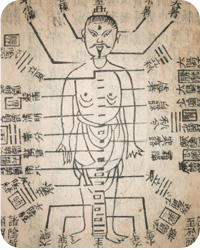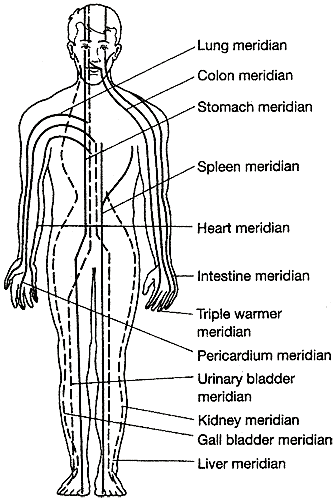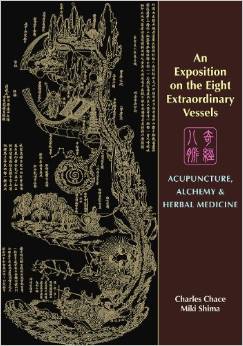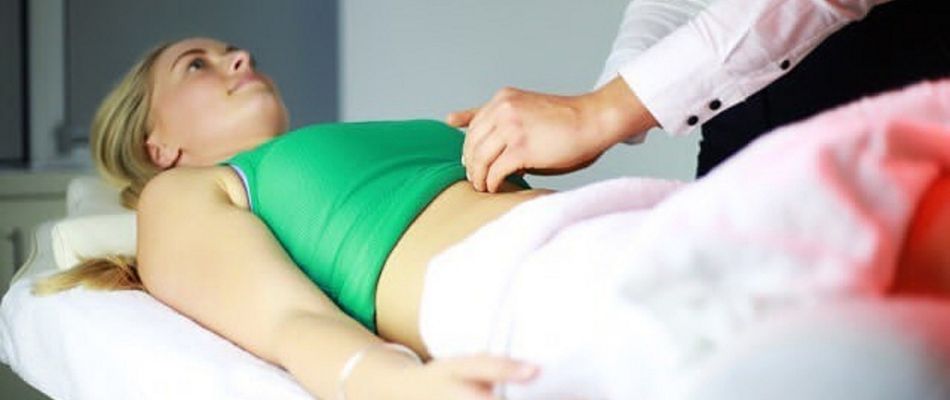Acupuncture Smackyoupuncture! Early on in my tai chi practice, I barely got my head wrapped around all of the Chinese words and foreign concepts. Then, I found out there was a relationship between acupuncture and tai chi and I was supposed to know about a series of routes that run through my body giving me energy.
Daunting isn’t it? Still drives me nuts. But not because I am overwhelmed anymore. Now it’s because the more I progress, the more I feel great, and the more I feel development inside, I want to know what’s going on.
By looking at acupuncture and tai chi, we see how energy resides and moves throughout body via the extraordinary vessels and meridians. As a general rule, specific tai chi moves do not correspond with specific acupuncture points or meridians. Instead, tai chi improves and increases the flow of energy that the body uses to maintain health or directs to places of need such as injuries.
Here’s the cool thing: progress in tai chi can be enriched with a basic knowledge of the Eight Extraordinary Vessels and the relationship between tai chi and acupuncture meridians. I’ve dug into the research and am going to break things down so your practice benefits or to motivate you to (hopefully continue) to suggest tai chi to your acupuncture patients.
What are the Eight Extraordinary Vessels?
The eight extraordinary vessels are connection points for the twelve primary meridians and also serve as reservoirs for energy that can be transported through meridians to organs. The vessels store and distribute energy throughout the body and influence metabolic activity. Rather than thinking about the them individually, it is better to think about what the purpose of the eight vessels are so that we get a better idea for what we are fixing or improving when we do acupuncture and tai chi.
The 8 Extraordinary Vessels are:
- 2 Motility Vessels: Yin and Yang (Qiao Mai): facilitate motion up the legs and balance of the right and left sides.
- Conception Vessel (Ren Mai): is the source of energy and influences the endocrine and respiratory system. Flows up the center of the body.
- Governing Vessel (Du Mai): influences the central nervous system. Flows up the spinal column into the brain.
- Belt Vessel (Dai Mai): runs around the center. Influences flow through vertical meridians by constricting or loosening.
- Penetrating Vessel (Chong Mai): flows throughout the body and returns chi to the source. Influences other systems for this reason.
- 2 Linking Vessels: Yin and Yang (Wei Mai): preserves yin and yang energy and distributes internal and external chi.
Main take-away: The whole body funds your health. Western medicine focuses just on the location of the problem. Eastern medicine focuses on the entire system. Your practice raises the health of the whole system and relies on the body’s intelligence to send the help (chi) where it needs to go.
What Does Eight Extraordinary Vessels Mean?
The translation of eight extraordinary vessels is really interesting and helps us conceptually understand what it means. Let’s take a look: Qi Jing Ba Mai 奇經八脈 can be broken down:
- Qi 奇 translates as rare, odd, or strange but is also used in wonder or surprise. This tells us that it is not completely understood and in truth, research on the 8 extraordinary vessels is ongoing. It also tells us that there is something surprising and therapeutic effects have been shown by focusing acupuncture on the extraordinary meridians even when other treatments have failed.
- Jing 經 means channel or meridian but is also used as a preposition to mean “through.” So yes they are a kind of place but also connote movement or moving through.
- Ba 八 means 8.
- Mai 脈 is interesting. Translated in this situation it means vessel but Mai also means “pulse” when combined with 冲 (rushing) and even “range” like with mountains.
So taken literally, the translation of Qi Jing Ba Mai is odd meridians, eight vessels. Putting it together conceptually, it is a big picture term showing us how everything is connected. It is a way for acupuncture and tai chi practitioners to think about how to help a person feel better or have more energy by focusing on improvements to the body’s entire system.

An Easy Explanation of the Eight Extraordinary Vessels
Imagine you grew up living in New York City. Driving, riding your bicycle, taxis, the whole lot. Then one day someone says, “Have you ever taken the subway?” And you say, “What’s a subway?” You never heard of this subway thing and it sounds nice and all, but you have your bicycle and enjoy a good walk. However, now you know about this subway thing and are curious. You try it once and are now second guessing the taxi system. You start to see its role in NYC and hope to benefit from it when you know how to use it to get somewhere. You have even heard of people who now only use the subway. Scary.
As you travel through the subway system you leave your borough or city and take a train line to cover a great distance. You may stop at a station which serves two primary purposes: it is a connection point to get onto another trainline, and it also has stores, restaurants, coffee shops, and ticket counters for you to fuel up and buy whatever you need to keep you moving and happy.
The organs are the cities and neighborhoods, each with a very specific purpose. You travel to these neighborhoods via meridians which connect at the eight extraordinary vessels. These not only serve as connection points but are also reservoirs of energy. Just like you buying groceries (fuel) to take back home (an organ), the energy stored in the eight extraordinary vessels overflows to nourish an organ when there is illness or low energy.
At the risk of beating this transportation metaphor into the ground, let’s take a look at when things go wrong to begin to understand the relationship between acupuncture and tai chi. What if your train is slow or late? You, everyone, and everything doesn’t get to where it needs to go on time. Imagine the cascading effect to all the other processes that are late. What if your trainline is closed or cancelled? Think of all the energy that has to go into finding a different route or way. Think of all the time and money (energy!) sunk into construction and repair. What if the shops at the station are empty? You go home hungry and in need of food. Or maybe your house is dark because they didn’t have lightbulbs or your place is dirty because there are no cleaning supplies.
How are Tai Chi and Acupuncture Related?

Acupuncture and tai chi are related because both practices put order to the transportation system that our wellness is dependent on. For the acupuncturists or patients out there, I think it’s important to see how correct alignment and movement can have a positive impact on your progress and also provide a more down-to-earth understanding for what is going on when we start feeling better. Movement makes most of us feel better. For tai chi people, acupuncture knowledge gives us insight into what is happening on the inside when we are doing the form with the intention of improving our health and wellness. Having a basic understanding of what we are trying to influence helps us direct our intention.
Acupuncture uses needles to detect and correct imbalances of energy flow along the meridians. If there is too much or an undesired amount of an energy, it is released. If there is too little, acupuncture builds it up.
How does this apply to Tai Chi?
- Nourishing the organs: the movements of tai chi are designed to drive energy to and between the organs.
- Purpose of relaxing: Your ability to relax correlates with increased flow.
- Awareness of injury/blockage: Injuries and tight muscles (knots) are messages from your system that blood and energy are not traveling right. In any other sport you say: “Aw d@%m I hurt my shoulder again!” In tai chi you say: “Thank you for showing me that old injury, now I can work to release it.”
Does this blow your mind? As a beginner, can you see how these movements account for that feeling of well-being? This is how so many different ailments have improved from tai chi. For internally directed practitioners, further study of the eight vessels reveals the roadmap needed to balance your energy and move it around.
Should Acupuncture and Tai Chi Be Done Together?
There are benefits to both tai chi and acupuncture and now there is growing evidence and research that doing both practices together can have greater therapeutic effect. In a study of the outcomes of patients who combined different alternative medicine they concluded that:
Taken together, although there are some clear limitations regarding the body of research reviewed in this study, a tentative conclusion can be reached that acupuncture, Tuina, Tai Chi, Qigong, or TCM-FEMT represent beneficial adjunctive therapies. Future study reporting in this field should be improved regarding both method and content of interventions and research methods.
Effects of Acupuncture, Tuina, Tai Chi, Qigong, and Traditional Chinese Medicine Five-Element Music Therapy on Symptom Management and Quality of Life for Cancer Patients: A Meta-Analysis
And it’s not just “activity.” Dr. David Sobel found that tai chi specifically functioned like acupuncture:
Tai Chi and Qigong, when taught as mindfulness relaxation therapies can help clear tension blocks, which facilitates a natural healthful flow of Qi or life energy, as well as blood and lymph circulation…the gentle massaging of the body, which sets Tai Chi and Qigong apart from other exercises, results also in “massaging the internal organs” and supporting their function and the flow of Qi, or life energy.
Dr. David Sobel
Let’s make sure that we are not taking this idea too far though. Some argue that there are specific tai chi movements that have specific effects on specific meridians. I am not debating this and it could be true. However, it would be incredibly difficult to feel or sense or even prescribe a movement for a specific ailment for that matter. Better to do tai chi or acupuncture with the intent to improve the whole system and let the body decide where to send the extra clean energy you just gave it.

Meridian Overview in 5 minutes
Okay, you’ve hung with me this far and hopefully you are blown away. In order for you to get the most out of your acupuncture and tai chi we need to add one more chapter to the story. We need to talk about the superhighways of energy that are running through our body that you are trying to clean, fill, and unblock with your practice.
Understanding the body’s meridian systems takes, well, a medical degree and A LOT of time practicing. However, there is some basic knowledge we can get in a meridian overview that can catapult your qi gong and tai chi practice to the next level. This essay is aimed at providing avid tai chi and qi gong practitioners an introduction to the knowledge that is needed to advance skills.
Let’s start with a disclaimer for all of the acupuncture nerds out there! We (tai chi practitioners) love you and every way you have added to the western dialogue about Chinese Medicine and theory. If you are an acupuncturist and a tai chi practitioner – WOW! What a combo. You are ahead of the game. However, the rest of us would benefit from an overview of the meridian system to enhance our tai chi, qi gong, and meditation. So that:
- When we begin to feel energy inside of us, we know where to direct it.
- When we know where to direct it, we can get concentrate on the harder points to get past.
- When we are healing, we can raise the level of our energy and let it overflow into the needed places
Here we go!
What Are Meridians?
The meridians are energy highways that connect the major organ systems. They keep us healthy by allowing energy to flow between the organs and needy areas. If we are unhealthy we need to increase the amount of energy, increase the flow, or stop a blockage. Your tai chi, qi gong, or meditation practice enhances this.
Main take-away: If energy (qi) freely travels through the meridians, your organs work in harmony and you remain healthy.
How Many Meridians Are There?
There are 12 main meridians. Know that some people include the 8 extraordinary vessels for a total of 20 (12 Organ Meridians and 8 Extraordinary Meridians). Each has a function and a symptom if it is not in balance. For example, the Spleen Organ Meridian distributes nutrients throughout the body, maintains muscle and limb tone, and regulates blood flow. If it is imbalanced you may experience diarrhea, constipation, fatigue or brain fog.
The 12 Organ Meridians are:

- Lung
- Large intestine
- Stomach
- Spleen
- Heart
- Small intestine
- Bladder
- Kidney
- Pericardium
- Triple Warmer
- Gallbladder
- Liver
Are Meridians Real?
Any discussion of meridians is followed by doubt of their existence. The western theory goes like this:
If I can’t cut into it, measure it, or see it – screw it.
The Eastern rebuttal follows with:
Thousands of years of documentation, across at least 4 independent pursuits (Thai, Japanese, Indian, Chinese) created a complex medical system that can be tested and verified on the individual level and that technology is only recently been able to validate (Chenglin et al. 2013).
Main take-away: Believe in them and benefit from it. Doubt their existence and do more homework. Ignore them and continue on as you are. No harm no foul. But you have nothing to gain from doubting their existence.
What is the Most Important Take-Away for Tai Chi Practitioners?
The 12 Organ Meridians, the ones you hear so much about, are important. Tai chi and qigong indirectly work to fortify these systems. I say indirectly because we are not typically focusing on these points throughout practice. BUT! Your practice makes for a strong, tonified system.
Here is where things get extraordinary.
The 8 Extraordinary Vessels absorb excess energy from the primary channels and act as reservoirs (Focks, 2008). In times of low energy or poor health these reservoirs are tapped to maintain health, promote health or instigate healing.
Main take-away: If you are meditating, doing qi gong, or doing tai chi, you are building qi which flows and can be felt in the 8 Extraordinary Meridians. As a notable example, the Microcosmic Orbit introduced by Mantak Chia is a sitting meditation that drives energy through the back, Governing Channel back around through the front, Functioning Channel.
Your job is just to go to work!

An incredible intelligence has been baked into the tai chi form, qi gong form or meditative set by people who had a level of sensitivity that was so high that they could determine which moves and postures would produce the greatest results. You just need to go to work and provide your body with the opportunity to energize and heal.
You can start by continuing on with these two articles:
Acupuncture Points of the Conception Vessel
Acupuncture Points of the Governing Vessel
Ming Men – Acupressure point with powerful implications
Then, here is more reading:
- This is a great eight extraordinary vessels book: An Exposition on the Eight Extraordinary Vessels: Acupuncture, Alchemy, and Herbal Medicine
- Chenglin, Liu, et. al. “X-ray phase-contrast CT imaging of the acupoints based on synchrotron radiation.” Journal of Electron Spectroscopy and Related Phenomena (2013).
- Focks, Claudia. E-book-atlas of acupuncture. Elsevier Health Sciences, 2008.
- Use of and interest in alternative therapies among adult primary care clinicians and adult members in a large health maintenance organization.


